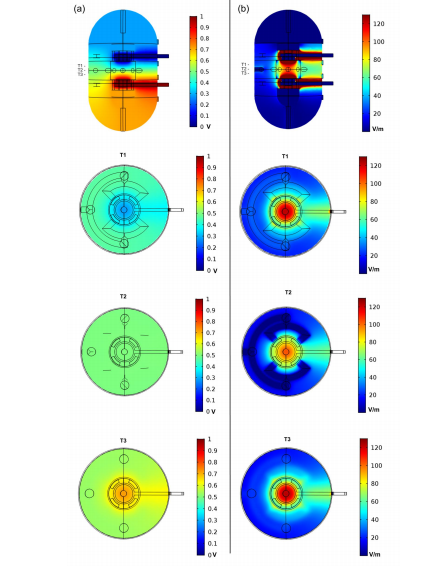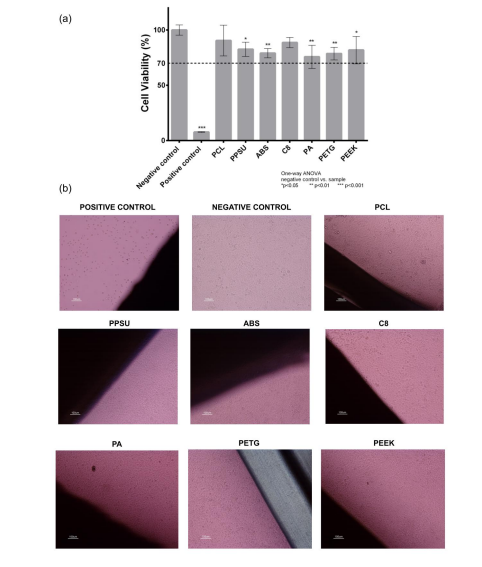Researchers from the US and Portugal are refining tissue engineering applications further, releasing the findings of their study in the recently published ‘A Multimodal Stimulation Cell Culture Bioreactor for Tissue Engineering: A Numerical Modelling Approach.’ In creating a new bioreactor for 3D printing, the authors worked to promote reproducibility and optimization, fabricating a design not possible using conventional techniques.
In most bioprinting, cells are seeded onto scaffolds—also the source of much study, whether in regard to new techniques, enhancements, or interface engineering—and then researchers must hope for viability. Promoting cell growth and sustainability is one of the greatest challenges in any type of bioprinting, and often devices like perfusion flow bioreactors are used in replacing culture mediums to remove toxins. In some cases, they are also used for mechanical stimulation through fluid flow shear stress (FFSS). Electric field stimulation devices can also be easily used to encourage cells to grow, mature, and differentiate.
The bioreactor used here was part of a previous study conducted by the authors, but now updated (using SOLIDWORKS 2018 Student Edition ) to include capabilities in E-Field stimulation and fluid flow mechanical stimulation. 3D design was performed in SOLIDWORKS 2018 Student Edition. Assessment of the new design was part of this study, leaving the team to create a numerical finite element analysis (FEA) of the model.
With FEA, the researchers could project input conditions for the bioreactor, further enhancing effectiveness of cell stimulation, determined from in vitro data. Overall, in vitro tests can offer ‘essential’ information for confirming ranges of multimodal stimulation—projected via numerical studies.

Numerical finite element analysis (FEA) analysis of the proposed bioreactor design with a DC electric stimulation parallel plate capacitor set-up with lateral and top slice views. The three top views represent the ROI upper slice (T1), the ROI middle plane slice (T2) and the ROI bottom slice (T3). (a) Electric potential distribution predicted in the bioreactor due to DC stimulation. (b) E-Field magnitude distribution predicted for the same electric DC stimulation conditions.

Numerical FEA analysis of the proposed bioreactor design for a laminar perfusion flow with lateral and top slice views. The three top views represent the ROI upper slice (T1), the ROI middle plane slice (T2) and the ROI bottom slice (T3). (a) Pressure distribution predicted considering applied inlets velocity of 0.003 m/s and a outlet pressure of 0 Pa. (b) Fluid velocity distribution predicted for the same inlet/outlet conditions. The velocity distribution at the ROI middle plane slice is presented in more detail in a top view inset at the right of the slice plane.
“Electrical and mechanical stimulation conditions in the region-of-interest (ROI) were considered for bone cell stimulation optimization, according with reference values obtained from two previous in vitro studies on bone cell stimulation, one applying mechanical stimulation, and the other using E-Field stimulation,” explained the authors.

Novel bioreactor design: (a) Vertical cut view of the bioreactor design, where the parallel electrodes set up, the upper and bottom inlets and the inlet flow splitters can be observed. (b) Horizontal cut view of the bioreactor design, where the radial outlet system can be observed. The green regions represent the region-of-interest (ROI) where the scaffold will be placed, represented by a cylinder with 4 mm of height and a diameter of 10 mm. (c) CAD bioreactor design assembled in frontal view, the main outlet hole is visible in the middle. (d) CAD bioreactor design assembled in lateral view, showing both electrode connector wires (in brown).
Flow splitters were added between the inlet and the scaffold, resulting in ‘indirect flow prevalence.’ Inlets and outlets were fitted with hose joiners, connecting them to the perfusion pump. The cell culture chamber was separated into two different areas for cell cultures and cell seeding exercises. Materials for use in the platform were required to be non-toxic and suitable according to ISO 10993-5 standards.

Bioreactor geometry volume mesh created using COMSOL Multiphysics, with 1.9 × 106 elements, and an average element quality of 0.65.
“Accordingly, in the direct contact test, cells cultured in contact with all the materials presented normal fibroblast morphology with no evidence of any inhibition halo effect or cell death. According to the cytotoxicity tests results, all candidate materials are suitable for our bioreactor AM fabrication,” concluded the researchers. “We will consider C8 and PETG as materials of interest for future design fabrication. C8 is a new material with good layer adhesion and surface quality, which are key features for the perfusion flow. The C8 supplier datasheet reveals that this material has a higher tensile strength than ABS, resulting in improved mechanical characteristics, which are important for the overall robustness of the bioreactor to withstand the tightness of pressure chambers.”

Cytotoxicity assay with L929 mouse fibroblast according to ISO 10993-5 standards: (a) indirect contact (MTT protocol); (b) direct contact (digital images of the material samples and the negative and positive controls, fresh culture medium and Latex, respectively). A one-way ANOVA with no corrections for multiple comparisons (Fisher’s test) statistical analysis was performed using GraphPad Prism6.
“A design–numerical modelling approach will be essential to understand the underlying biophysical effects of electric and mechanical stimuli in cell cultures and can be a powerful tool for standardization of stimulation protocols considering different bioreactor designs and specific TE outcomes.”
What do you think of this news? Let us know your thoughts! Join the discussion of this and other 3D printing topics at 3DPrintBoard.com.
[Source / Images: ‘A Multimodal Stimulation Cell Culture Bioreactor for Tissue Engineering: A Numerical Modelling Approach’]Subscribe to Our Email Newsletter
Stay up-to-date on all the latest news from the 3D printing industry and receive information and offers from third party vendors.
You May Also Like
Gorilla Sports GE’s First 3D Printed Titanium Cast
How do you help a gorilla with a broken arm? Sounds like the start of a bad joke a zookeeper might tell, but it’s an actual dilemma recently faced by...
Nylon 3D Printed Parts Made More Functional with Coatings & Colors
Parts 3D printed from polyamide (PA, Nylon) 12 using powder bed fusion (PBF) are a mainstay in the additive manufacturing (AM) industry. While post-finishing processes have improved the porosity of...
$25M to Back Sintavia’s Largest Expansion of Metal 3D Printing Capacity Since 2019
Sintavia, the digital manufacturing company specializing in mission-critical parts for strategic sectors, announced a $25 million investment to increase its production capacity, the largest expansion to its operations since 2019....
Velo3D Initiates Public Offering in a Bid to Strengthen Financial Foundations and Drive Future Growth
Velo3D (NYSE: VLD) has been among a number of publicly traded 3D printing firms that have attempted to weather the current macroeconomic climate. After posting a challenging financial report for 2023,...































